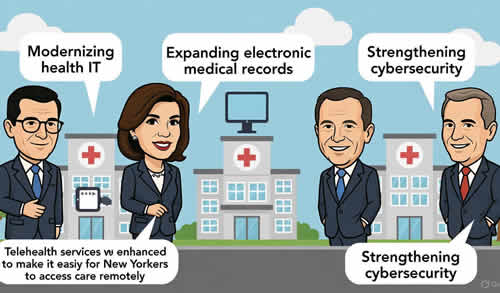On April 28, 2025, Mayor Eric Adams announced significant housing investments for New York City’s Fiscal Year 2026 executive budget, dubbed the “Best Budget Ever,” during an event at Woodhull II. The budget allocates $24.7 billion over 10 years for affordable housing, $350 million for NYCHA repairs, $229 million for nearly 6,000 supportive housing units, and $650 million to address homelessness and mental health. Emphasizing the “City of Yes” initiative, Adams highlighted record-breaking housing production, tenant protections, and homeownership programs to create, connect, and keep New Yorkers in homes. The administration aims to address the 1.4% vacancy rate, support vulnerable populations, and protect small property owners, with Deputy Mayor Adolfo Carrión praising the collaborative efforts of city agencies and advocates like the Supportive Housing Network of New York.
Mayor Adams Unveils New Investments in Upcoming Mayoral Budget to Create More Homes, Connect More New Yorkers to Homes, Keep More New Yorkers in Homes
April 28, 2025
Deputy Mayor Adolfo Carrión, Housing, Economic Development, and Workforce: Buenos dias. Good morning, everybody. I love that spirit. You know what? We had been here in this building. We came in through the back. I didn’t recognize it. What a beautiful day. What a gorgeous day.
I am Adolfo Carrión, the deputy mayor for Housing, Economic Development, and Workforce here in the City of New York. I have to say, what a wonderful way to start Budget Week. This is Budget Week. Today we get together to celebrate the city’s future investments in housing for the first time as the City of Yes.
Every single person here today, whether you’re a government agency, well, you can’t be a government agency if you’re a person, right? A housing provider, an elected official, an advocate, or even a tenant played an important role in transforming our city into the City of Yes. Years of hard work have put us all in the spot we’re in today. And I’m excited for the mayor, the leader, who in the face of those who said no, continued and kept us on the path to the City of Yes, to unveil how we as an administration are going to capitalize on the historic accomplishments we’ve made this past year.
But before we do that, I wanted to introduce you all to someone who represents what this administration and what this city and what this project here, what this understanding is all about, what this city has done to make sure everyone has an opportunity. It is my pleasure to introduce George Griffin.
George Griffin: Thank you, everybody. Good morning. My name is George. It’s a pleasure to be here with the mayor and to speak upon the mayor. My name is George. I’m here today because, because of supportive housing, I grew up across the river in New Jersey. I was born in New Jersey. I lived in a two family house in New Jersey. I had, unfortunately, when I got older, I ended up in a shelter in New York City. It was not easy. I was there for several years.
Eventually I got a spot in the city’s supportive housing network. Five years later, I feel grounded. My supportive home is like a family. Everyone there is to help me like my social worker, [Aiken], my supervisor, [Sable], also see CUCS and also the mayor and his staff.
My life today shows that government can help people. It can help people find a place to sleep. It can help people get on their feet. It can help people start over again. I am proof of that. We cannot give up on helping people. Not today. Not ever. We need more supportive housing like mine, more stories like mine. That is why I’m here today. Finally, I am excited to welcome the mayor of New York City, Eric Adams.
Mayor Eric Adams: Thank you so much. Thank you, George. And I asked [Aiken,] his social worker, to join us as well because, sometimes we look at these different components and pieces that we really fail to understand the role of the social worker and how they prevent people from drowning in the sea of government inefficiency
We have a history in government, all over the country, where you just throw people in the pool and tell them to figure out how to swim on their own. Some make it back to the shoreline, but far too many, matter of fact, the overwhelming number of them, they drown in just the sea of despair, of uncertainty, and they just never get the support that they deserve.
The lifeguard, I believe, has continuously been these social workers. They’re there. They hold their hand. They do not judge. They do not state what you should have done or should not have done. Their role is just to put people’s lives back together and navigate the complexities of government. Government is complex. Government can often be callous. Government is overwhelmed. And many of the governmental employees are experiencing trauma on their own.
And so it’s challenging just to navigate the system to have someone go from being in the shelter to supportive housing. There are a number of steps in between. And if you don’t have someone like an [Aiken] that is willing to sit down and not get frustrated with the complexities of government, we’ll never get these numbers that we are showing. Our records are fine. But what about the supportive staff, staff that allows us to get the records that we have shown? So, [Aiken], hats off to you for what you have done. And the social workers all over this city. Underpaid, undervalued, but overly producing over and over again.
And so we’re excited. This is going to be the best budget ever. As the deputy mayor stated. And we are really proud to be back here at Woodhull II. I live blocks from here. And so I know this community so well. And what this hospital has done and has redefined how we use healthcare facilities to fill in many of the gaps.
Those who sit in our emergency rooms and use it as their primary care facilities and healthcare providers, they’re the same people who are dealing with housing. They’re the same people that may be dealing with food insecurity. Same people that are dealing with educational failures and opportunities. That place is a reservoir for those who need governmental services.
And Woodhull has been a partner in stating, let’s catch people there to find out what their needs are as well as their medical needs. Because oftentimes their medical needs come from emergency situations that could have been prevented if we had real wraparound services like we’re doing with our lifestyle medicine in our Health and Hospital facilities.
So some of you may remember we were here last month to cut the ribbon on a new 93 units of supportive and affordable housing. We were excited about that initiative, but we’re going further than that. Woodhull is critical to the peace of our cities. We’re getting people the housing, the help and healthcare they need. Housing, help and healthcare that they need.
But when you zoom out, you’ll see that we’re doing work like this all across New York city. Woodhull is a symbol of the work we’re doing throughout this entire city. And that’s what we want to discuss today. Whether it’s building records amounts of affordable housing passing our historic City of Yes. And this initiative, the most comprehensive housing reform in the history of the city. All events in bold.
Neighborhood plans to build tens of thousands of new homes from Brooklyn to the Bronx, Queens, Staten Island, Manhattan, every borough is being touched and every borough is being hit to build more housing there’s simply no other way to put it. This is the most pro housing administration in the history of our city. The numbers don’t lie. The numbers prove it. And we’re going to continue to break the records that are needed to get people from homelessness into housing.
We have thrown open the doors to new solutions and new housing across the five boroughs and work to make New York city, the best place to raise a family. And that means creating more homes, connecting more New Yorkers to homes, creating more homes and connecting New Yorkers to homes and keeping more New Yorkers in the homes they already have. That’s the key here. Create, connect and keep.
We want New Yorkers to be able to stay in the homes in the communities that they spend so much time in developing. We don’t want our New Yorkers displaced from the communities that they’ve been a part of for so many years. That is what we have done every day since we came into office. In fiscal year 2026 the executive budget is going to really reflect the success and the continued success of moving in the right direction.
This budget week, we’re unveiling the Best Budget Ever. We know it because the numbers are going to display that. And we’re going to start with one of the most important aspects of it. And that’s housing and affordability of housing. Investing in housing, schools and safety initiatives that would make New York city the best place to raise a family. And that starts with creating more homes, must create more homes.
We have the housing deficit, 1.4 percent vacancy rate. There’s just not enough inventory. So we have to move forward and create more homes. And which is why we are investing $24.7 billion in affordable housing over the next 10 years. And $350 million to speed up repairs and renovation at NYCHA.
NYCHA was always ignored in the housing plan. First administration to include NYCHA in its housing plan. And we’re seeing the results on many levels, including the NYCHA land trust and other ways to develop and build out NYCHA with an $80 billion capital deficit. If you don’t think differently, you’re never going to resolve the problems in NYCHA. And we’re not afraid to tackle them and take them on.
We’re connecting more New Yorkers to homes, to particularly those who need them the most. We all know that home is more than just four walls. It is a precursor to sleep, to allow you to experience the American dream and to build a life and a pathway to prosperity and opportunities. And that’s why we’re doing it.
We’ve invested $900 million in supportive housing last year alone. $900 million so that we can bring the Georges into housing more and more and more. And hear the great stories of going from where you were to where you are and give you the stability that you deserve. And we’ve unveiled a $650 million initiative to curb homelessness and tackle severe mental illness during our State of the City Address this year. So important.
We need our help from Albany to pass the involuntary removal bill. We can’t keep passing by our brothers and sisters who are on the street that can’t take care of themselves. We are going to do our part, but we’re going to need our partnership in Albany. Thanks to the governor for pushing this initiative forward.
But when you look at all of these initiatives, we’ll give more New Yorkers a safe, supportive place to sleep at night, to rest their heads and get help. But we are not stopping there. Supportive housing like the kind here at Woodhull is a lifeline for vulnerable New Yorkers. Giving them the homes and social services they need in one easy location.
We’ve already shattered supportive housing records, not one, but two years in a row. Just a great job, deputy mayor, for what you have done. Deputy Mayor Carrión has been focused on this, as I speak to him often, that we have to break another record. Never, never stopping on his morals. His team over at HPD is really getting it done. Thank you. With this budget, yes–
And with this budget, we will strengthen those efforts and invest an additional $46 million to create or preserve nearly 6,000 new units of supportive housing as part of a total investment of $229 million over the financial plan. This is nearly 6,000 homes where someone can reclaim their life and renew hope. Nearly 6,000 homes where New Yorkers can heal. Homes that provide a path to stability, community, and common purpose.
With two-thirds of all New Yorkers paying rent, there’s no question we are a city of renters. A city of renters. But we haven’t stopped being a city of renters only. With the initiative over at HPD, we’re also delving into home ownership, an amazing program there to first-time homebuyers, because we want people to be able to own as well as rent.
But many New Yorkers are struggling to keep a roof over their heads. Too many still feel that pressure, face potential eviction, landlord harassment, or unacceptable living conditions. It’s not enough to create new homes or connect New Yorkers to homes. We have to keep New Yorkers in their homes that they have already. That is crucial to what we hear every day.
We’re not going to accept where renters are priced out of the chance to build their home. That’s why we created the first-ever tenant protection cabinet and expanded the homeowner help desk to the entire city. And it’s why today we’re making new investments in our tenant protection program, anti-harassment tenant protection program, that include legal services to help tenants experiencing landlord harassment, whether it’s creating records amounts of housing, investing millions of dollars, to connect New Yorkers to the homes they need, or keeping New Yorkers in their home. They already have.
This is the most pro-housing administration in our history. Full stop. Period. We are proving it every day. And with the best budget ever, we’ll double down on these efforts and build the housing and homes that working people and families need and deserve in the city and continue to make the city the best place to raise children and families. Thank you. Thanks so much. Thanks to the entire team. And thank you, deputy mayor.
Deputy Mayor Carrión: Thank you, sir. Thank you, Mr. Mayor. The best budget ever. You’re going to see it. You’re going to see it. It’s true. Let me just say, mayor, and you often say this, we also have the best darn team in the country. Look at these folks running agencies, whether it’s the housing authority, whether it’s the Office of Management and Budget, whether it’s HPD, the Department of Social Services, and on and on. In all its manifestations, we have leaders who are leading the charge every day.
I want to take a moment to, it’s not in my prepared remarks, but I want to take a moment. You all have heard of an organization called SHNY. You know how acronyms become like a word. And then you ask people, well, what the heck does it mean? And they scratch their head. It’s the Supportive Housing Network of New York. Thank you for your advocacy and your leadership. You push the administration. You work with us. And now the proof is in the pudding.
So thank you, mayor. Thank you for highlighting where we are going. And as we look forward to creating and preserving even more housing, we must take some time to reflect and look back. The past 12 months, we have seen our city leaders, state leaders, housing leaders, planning leaders, accomplish truly monumental things to make sure New Yorkers are housed for generations to come. We must look back to what happened almost exactly a year ago when this administration partnered with our leaders in Albany.
We partnered with our leaders in Albany to pass legislation, related to housing, authorities related to housing, 485-X, which is a tax incentive to ensure affordable housing in the marketplace, 467-M, that allows the conversion of commercial properties to residential properties, the lifting of the FAR or floor area ratio, which allows for more housing to be built, to unlock the future construction of thousands and thousands of units of housing.
We must look back to December when the mayor, in partnership with the council, passed City of Yes for Housing Opportunity, a once-in-a-generation legal and architectural framework to fundamentally change how we build and how we think about housing in New York City. We must look back to the relentless hard work of HPD.
HPD did what they did to break records in housing production for our most vulnerable neighbors here in the City of New York. Give them a big round of applause. Way to go, HPD. And there’s a certain acting commissioner behind me by the name of Ahmed Tigani, who is a pillar over there. And the deputy commissioner for Development. And all the team, supportive housing, new housing, et cetera.
HPD was able to yet again, meaning for the second year in a row, break records for creating housing for the formerly homeless, older adults, and those in need of supportive housing. These continuous record-breaking years in 2023 and 2024 are not just numbers, but they are homes and opportunities for families and individuals, much like what we are standing in today and right now. Woodhull Phase II started as a number in our production stats and has become a place that offers shelter, services, and a bright future for its residents.
As a former planner and formerly HPD commissioner, I understand the importance of supportive housing. I’ve seen how it can change and save the lives of those who reside in it. That’s why, just as excited as I am to look back at what we have accomplished so far this administration… I’m even more excited to think about what we’re going to be able to do with the housing investments the mayor has put together to keep our city on the path of opportunity and the path to a City of Yes.
The mayor has laid out the blueprint for how he will continue producing and creating housing opportunities for New Yorkers. And with that blueprint in a city of yes, we will make sure all New Yorkers have safe, livable, affordable housing available to them. Thank you all very much. And I return you to the mayor of the City of New York.
Question: You know, you’re talking about the budget right now. I wanted to talk to you. How are negotiations going with the City Council with the undercurrent of everything going on? With the ICE on Rikers? Or with the speaker, primary for mayor? I mean, how are the negotiations going to go differently?
Mayor Adams: Excellent. So year after year, year after year, three years in a row, people ask, you know, how are things going? How are things going? I say the same thing. We’re going to land the plane. You know, I am the pilot of this amazing New York Airlines. And we always land the plane. You know, I don’t know why people would even doubt that we would land it again. All this stuff works itself out.
Yesterday, Kelly, I saw an opening of a documentary. I encourage everyone to go see it. It’s a documentary of when President Ford told New York, drop dead. And they refused to bail out New York. We were a billion dollars behind. Beame was the mayor at the time. Hugh Carey was the governor at the time. And, you know, the place, the city was in a dark place. And folks came together, UFT and others came together to make sure that we could handle it.
And eventually, the federal government bailed out the city. The governor put together a proposal to bail out and assist on the state level to bail out. But when you fast forward to 2022, when we were coming out of COVID, when we had 240,000 migrants and asylum seekers, when crime was surging in our city, and, you know, we looked to Washington to bail us out with the $7.2, $7.5 billion, whatever that number is. I know it’s in billions with a B. We looked to get that bailed out. We didn’t get it. So, you know what we did?
We rolled up the sleeves and we did it on our own. We got help from the governor. And we were able to produce record numbers, lowest number of shooters in New York City recorded history this quarter. More housing developed in our first and second year. And we look like we’re going to break it again in the third year of, you know, reducing the cost of child care, putting in place programs to allow our children to have summer youth employment, highest number in history, paying for college tuition to foster care children, bringing down child care from $55 a week to less than $5 a week.
No one bailed us out. We showed how we can manage a city. And so maybe the previous administrations and others didn’t tell us to drop dead, but we didn’t wait until we dropped dead. We got it done. And that is what history is going to show. So you’re going to be sitting in a movie theater in around about 10 years when I’m no longer mayor, and they’re going to do a documentary and show you how damn good I was as an administrator in this city. And so we would land the plane because I’m the pilot. So you don’t need your parachute. You’re going to be fine. I’ll land it for us.
Question: Just to ask about how to address high housing costs–
Mayor Adams: I’m sorry. I’m sorry, I can’t hear you.
Question: Oh, sorry. I’m [inaudible] the rent guidelines board. There’s going to be a preliminary vote this week. There have been calls for a rent freeze from certain activists and some mayoral candidates. What’s your position?
Mayor Adams: Yes. Listen, when you’re not mayor, you can be so idealistic that you’re not realistic. We need to figure out how to separate small property owners from the large property owners. If you are a mother or father that came from the Dominican Republic and you have an 18 unit building where your blood, sweat and tears are there. Everything went up, electric costs went up, gas costs went up, maintenance went up, repairs went up, insurance went up.
When those who don’t speak to them on the ground, I knock on the doors and I speak to these small property owners who everything they have is in their home. My little small three family house allowed me to pay my son’s college tuition. I never raised the rent of my tenants since they’ve been in the building for over 15, 16 years. But other people don’t have that luxury.
So when we start talking about just across the board, rent freezes, we need to talk to those small property owners. How does it impact them? Gas doesn’t freeze. Electricity doesn’t freeze. Insurance doesn’t freeze. The cost of running a building doesn’t freeze. And if we’re not allowing those small property owners to be able to have a small increment in their rent, you’re going to see what happened during the 60s and 70s, where we saw people walking away from their properties, where we see larger landlords come in and buy these properties. And then you really have a problem.
The wealth of Black and brown people specifically and probably the whole city in general. The biggest wealth you have is in your property. If you lose that property, it impacts your property. You don’t have that home equity loan to pay your child’s college tuition. You don’t have that retirement plan so if you decide to go to downsize later in life, you could pay for it.
We have to protect small property owners. I want to hear their plan on that. They should be rolling out, how do we protect small property owners? I’m not talking about the person that has 2000 units. I’m talking about that mother, that father that came from Puerto Rico or came from Alabama or came from the Dominican Republic or some parts of the country and put everything they had in this small property. That’s everything they have.
And we’re saying you cannot raise your rent. Then we’re not we’re not preparing them for the increases that they are experiencing. And so is idealism to state that. But realism is protecting small working class property owners. And that is what my bread and butter is. And so any plan of rent freeze should come with a plan of protecting them also.
Question: I’m wondering if you have any concern that there’s still not a budget on the state level while you’re trying to navigate your own budget.
Mayor Adams: Nope. You know what’s interesting is that we often get caught up in the middle of the process and all the uncertainty that comes with it. I just have this ability to see myself through crises on the other side. You’re going to be alright, folks. This is not the first time a budget has been delayed. This is not the first time there’s been a sticking point on budgetary issues.
What I’m hearing is that this is, you know, there’s some conversation around involuntary removal, discovery, maybe some conversation around the mask, of wearing a mask in our streets. You know, this happened before. I’ve been in Albany. It’s going to be alright. You know, we’ll see our way through it.
We’re resilient. This is the best city in the world because we have the best people in the world. And those are New Yorkers. And so we would get through this. The governor has the obligation, her north star is to deal with some of those important issues. I have a lot of faith in what the governor is doing. We’ve been able to get through it before. She has held strong on them.
And these issues are important. Involuntary removal is important. We should wait it out and get it done. Discovery is crucial. We’re seeing the recidivism. We just had a police officer shot over the weekend. The people who shot him had over 10 arrests. This recycling and recidivism is an important issue and discovery can help. And so these are important issues.
They need to stay there until they get it right. Until we can make sure that we do what’s best for our city to raise healthy children and families. So it doesn’t bother me. We would love for the budget to be done before we do our budget. But in reality, they need to deal with these issues. These are important issues for New York City. We’re creatures of the state. And if the state doesn’t get it right, it impacts us. And so as long as they take to get it right, we’re patient. I have the patience of Solomon. You know, thank you.
April 28, 2025 Manhattan, New York
Sources: NYC.gov , MidtownTrubune.com
Big New York news BigNY.com










